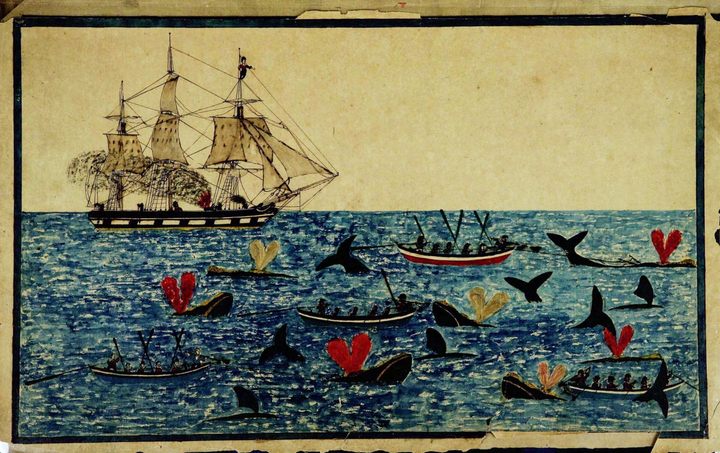
The Beautiful, Brutal World of Whaleship Art
The logbooks kept by 19th-century Nantucket whalers offer a colorful peek into the gruesome industry.
This story originally appeared on The Public Domain Review, and is reproduced here under the Creative Commons Attribution-ShareAlike 3.0 license.
The first European settlers arrived at Nantucket, an isolated island some 30 miles from Cape Cod, Massachusetts, in 1659. They built homes, Quaker meeting houses, and cattle farms, swiftly and forcibly colonizing the island, which was until then inhabited by 2,500 Wampanoag Native Americans. The word Nantucket is a Native American one, meaning either “far-away land” or “sandy, sterile soil tempting no one.” And the colonizers soon found it thus—too small and infertile to accommodate the number of agricultural plots necessary to support their growing population. So they looked to the sea (according to legend, quite literally) in 1690, when town selectmen climbed a sloping hill overlooking the southern coast. Here, they watched whales breach the Atlantic’s surface and pronounced the ocean “a green pasture where our children’s grandchildren will go for bread.”
This declaration proved prophetic, as for some 200 years Nantucket dominated the global whaling market. Such was its success that in 1851 Herman Melville in Moby-Dick marveled, “What wonder, then, that these Nantucketers, born on a beach, should take to the sea for a livelihood! … thus have these naked Nantucketers, these sea hermits, issuing from their ant-hill in the sea, overrun and conquered the watery world like so many Alexanders.”
In its early days, Nantucket whaling looked very different from the hub of activity that Melville, writing from his own experience, described. Initially, whaling took place close to Nantucket’s shores, where viewing platforms from which whales could be spotted were erected. Sightings might take place any time from November to April as during these months hordes of right whales—so called because they were the rightwhale to catch—returned from a summer of feeding in the far reaches of the North Atlantic. Their migratory route took them within a few miles of Nantucket.

Once a whale was spotted, a crew of up to six men, including indentured Wampanoag and Nauset Native Americans, would board 20-foot-long cedar boats in pursuit of their prey. If a boat drew even with the whale, then the animal would be harpooned and, following a chase, lanced and brought down. The dead leviathan was then hauled back to the bay, where blubber and baleen were flensed from its carcass and transported to try-houses. The blubber was boiled for oil, which was cooled, poured into casks, and sold alongside scrubbed whalebone at markets in New York, Boston, and farther afield.
This method of shore-fishery was gory, lucrative, and unsustainable. By 1730, the waters around Cape Cod and Nantucket had been overfished and the number of whales woefully depleted. But by this point, Nantucket’s whaling market was booming. The collapse of the Dutch North Atlantic fisheries, combined with increased demands for oil in Britain and America, had driven oil prices upwards from around eight pounds sterling per barrel in 1725 to 10 pounds in 1730. And so, incentivized by these convincingly healthy markets, well-off Nantucket merchants outfitted single-masted sailing vessels with dedicated crews and pursued their prey northward into the deeper waters.
Deeper-sea voyages made for longer expeditions, meaning that whalers might spend up to four years at sea, and as a consequence, two sorts of written and illustrated records emerged. The first was the logbook, an official, often tedious account kept by captains and first mates, which held administrative and financial information required by a ship’s owners. The second type of record was the unofficial journal, which might be maintained by anyone on board a ship. For although maritime life was arduous and sometimes frantic, a sailor or passenger over the course of months at sea could find time for reflexion and creativity and turn their hand to a variety of artistic pursuits.
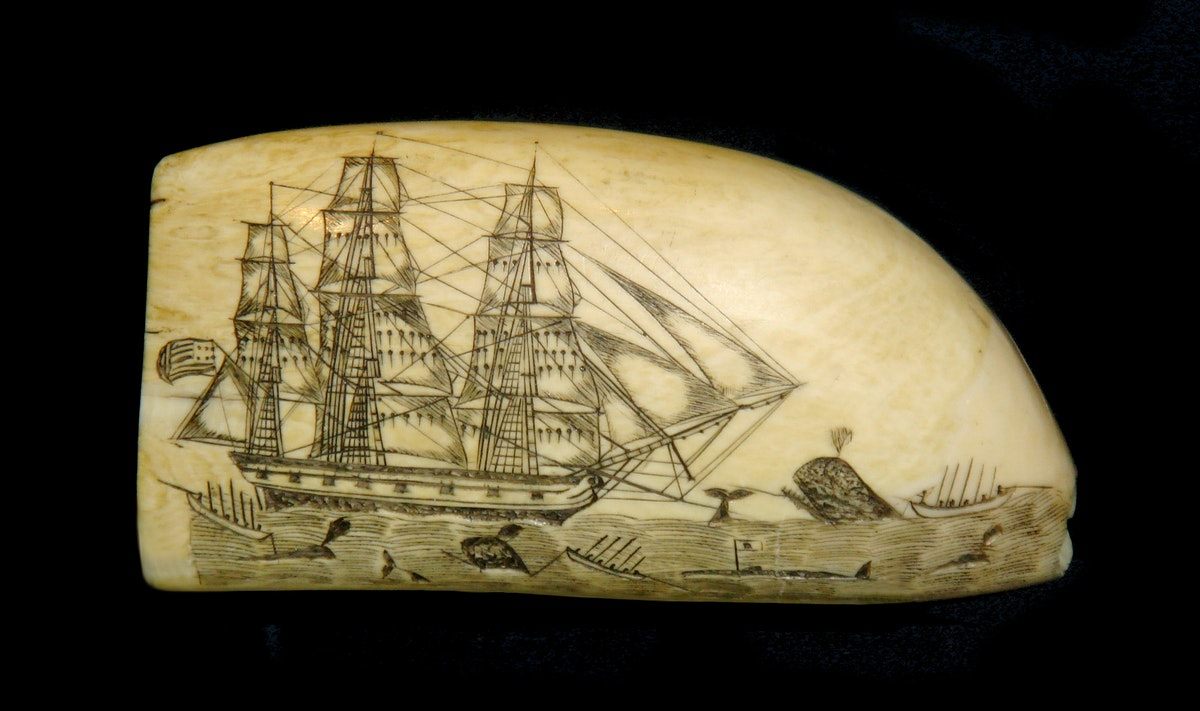
One such pursuit was scrimshandering, the craft of using a jack-knife or needle to engrave designs into bone and ivory obtained from whale teeth and walrus tusks. A work in scrimshaw could be decorated with a variety of subjects including whaling scenes and ships, portraits of lovers, and Masonic emblems.
The other strand of artistic practice was on paper, rather than three-dimensional. Although their rationales differed, both logbooks and journals were also frequently illustrated, replete with images of daily ship-board life, of faraway lands, and, most frequently, of whales. Hundreds of these have been preserved and digitized by the Nantucket Historical Association; the selection here, mainly from the 1840s, gives a unique insight into the world of Nantucket whaling.
Ship’s officers used logbooks for a variety of practical reasons: charting different species, sightings, and killings. Some logs, like that of the ship Indian Chief, kept by Thomas R. Bloomfield, contain careful, intricately-patterned drawings of the creatures, accompanied by the coordinates of where they were spotted.

Others include imprints made from stamps that, cut in the likeness of whales, were fashioned from pieces of wood, ivory, or bone. Different stamps were made to represent different species and carried different connotations. An image of a whale’s tail fluke denoted a whale sighting, whilst one of an entire whale, its slaughter. This visual lexicon, a semiotic language that even Roland Barthes might have appreciated, was developed as an efficient means of recording expeditions for vessel owners, who, rather than wading through dense logbooks written in cursive, often messy, script, might prefer to ascertain a voyage’s success by tallying the number of stamps its log contained.
Beyond official records, many journals were illustrated in ways that point to the sheer visual pleasure of the adventures, with whale chases a popular subject. The act of killing a whale deep at sea was not substantially different from doing so at shore, though the object of the hunt was no longer the right whale but the sperm whale, prized for its body oil—of higher grade than that of other cetaceans—and its spermaceti, a precious liquid wax found in its head.

Once a whale was sighted, which according to logs was a relatively rare event, the crew would lower whaleboats from the main vessel into the water. Vessels could contain up to five whaleboats: a larboard boat, starboard boat, bow boat, waist boat, and sometimes a starboard bow boat. Each was manned by a boat-header and up to five rowers.
As with shore whaling, the key was to draw close to the great mammal before striking it with a harpoon attached to a long coil of rope. Once the harpoon’s iron was firmly lodged into the creature’s flesh, it would either promptly die or, more commonly, flee, in which case a “Nantucket sleigh ride” would ensue. During this chase the frenzied whale would bolt with the boats in tow, until eventually, exhausted, the leviathan would collapse and be pierced to a gruesome death.

The cruelty of the hunt is not something that generally comes across in the logbook and journal depictions, where the blood and gore are replaced by anthropomorphized whales complete with unfathomably merry faces. Perhaps the brutality of whaling was difficult to reconcile with the principles of pacifism and non-violence that supposedly underpinned the Nantucketers’ Quaker way of life.
The success of the hunt was more or less dependent on the tractability of the whale. For the most part the creatures were fortunately docile, but some proved formidable adversaries. Such a beast was to be the undoing of the whaleship Essex, which departed from Nantucket on August 12, 1819. Captained by George Pollard, the 18-man crew was scheduled to spend two and a half years at sea, but disaster struck on November 20, 1820. On this day the crew spotted a pod of sperm whales. Whaleboats were greedily launched and several calves corralled; one smashed into a whaleboat, forcing its retreat, during which the cabin boy spotted an ominous shape looming beneath the Essex’s bow. The shape, it transpired, was a colossal sperm whale, some 85 feet in length, weighing approximately 80 tonnes.
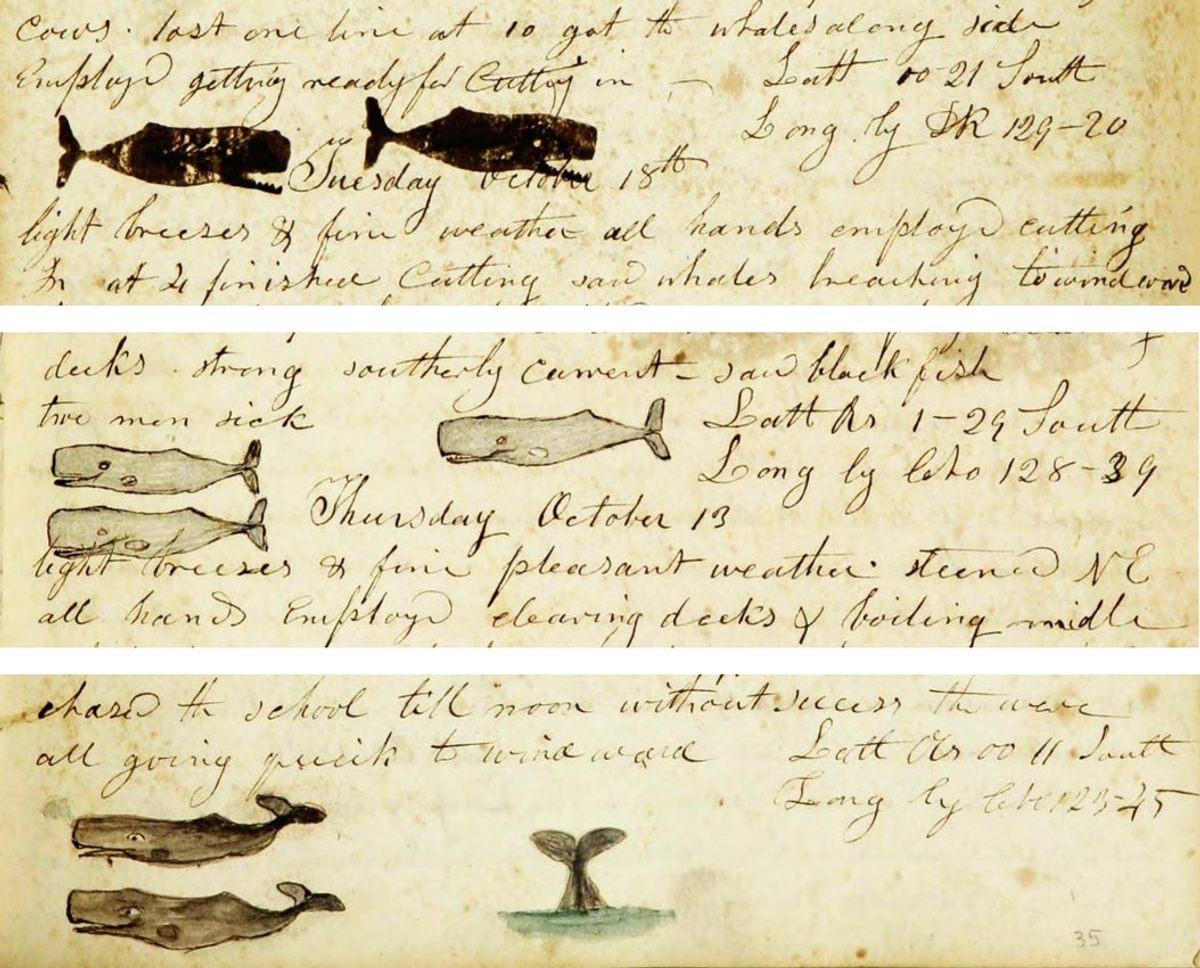
The Essex’s first mate, Owen Chase, recounts, “I could distinctly see him smite his jaws together, as if distracted with rage and fury,” and goes on to describe how the monumental creature
appeared with ten-fold fury and vengeance in his aspect. The surf flew in all directions about him and his course towards us was marked by a white foam of a rod in width, which he made with the continual violent thrashing of his tail. His head was about half out of the water, and in that way he came upon us, and again struck the ship.
The irate whale rammed into the Essex twice, sinking it some 2,000 nautical miles west of South America. The crew had just enough time to evacuate the ship into three small boats. Eight crew members survived by cannibalizing seven others, drawing lots to decide who should live and who be eaten.
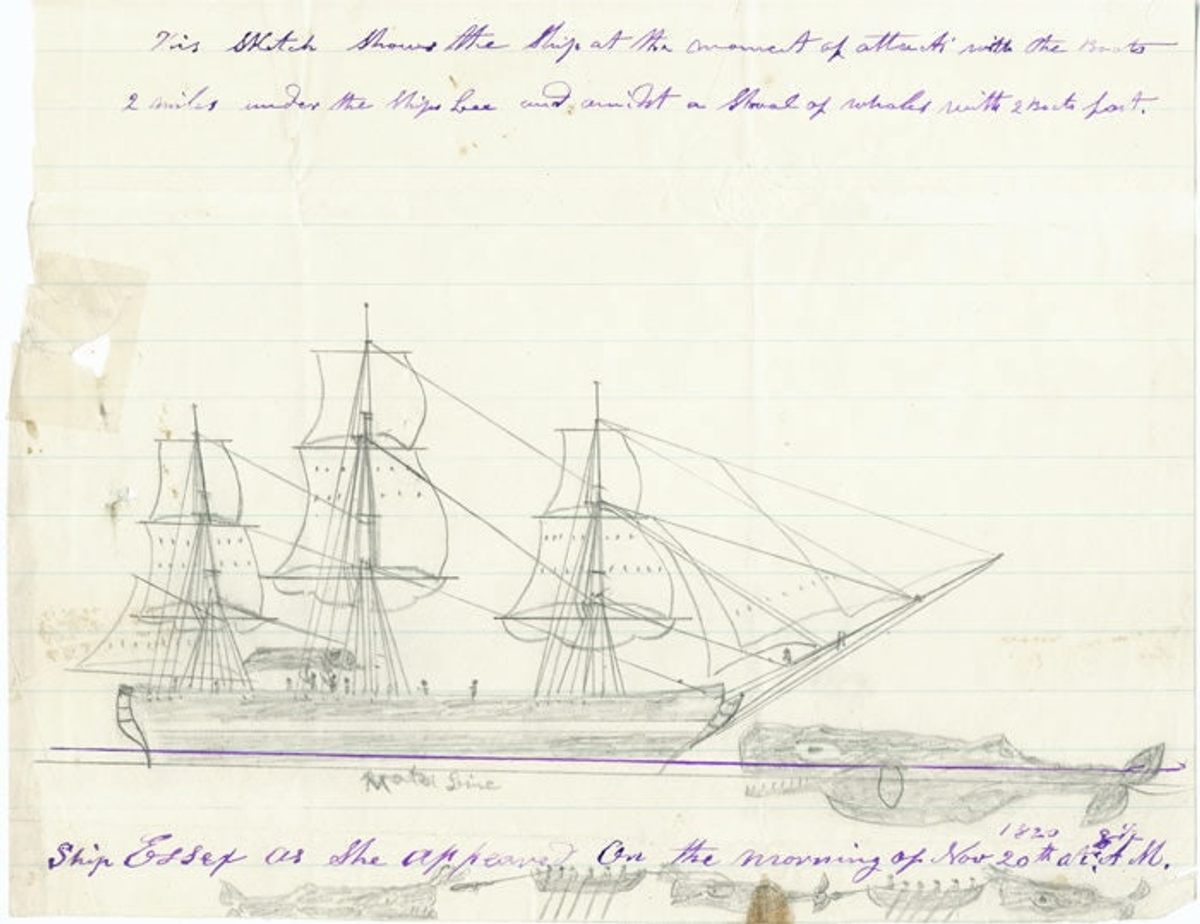
The horrors of the Essex, as described in Owen Chase’s narrative, provided fodder for the climactic scenes of Melville’s great American novel, Moby-Dick, which narrates the story of doomed anti-hero Captain Ahab’s quest for revenge on the great white sperm whale, Moby Dick. The epic culminates in a three-day chase in which the majestic Moby Dick demolishes the fictional Pequod, leaving Ishmael, the ship’s survivor and true protagonist, adrift at sea.
Of course, not all expeditions were so utterly dismal. Indeed, some afforded rare opportunities for working men and occasionally even women to travel the world. Susan C. Austin Veeder was one of the first Nantucket women to accompany their husband to sea. Her decision to do so was perhaps motivated by more than a sense of adventure, given that on his next voyage her husband deferred from his post as captain, took up with a Polynesian woman, and never returned home.
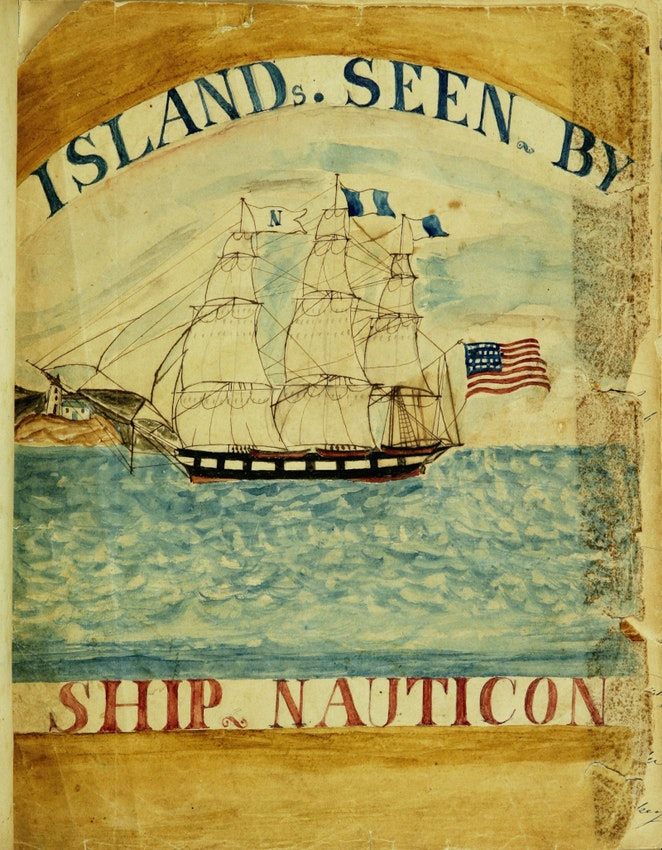
Susan’s journey aboard the Nauticon, which departed from Nantucket in September 1848 and returned in March 1853, took her across the Atlantic around Cape Horn to ports in Chile, Oahu, Tahiti, and as far north as the Fox Islands in the Arctic. Her journal, though written in terse, bleakly efficient language, brims with panoramic watercolors that judiciously delineate the places she visited and make clear that she was alive to her surroundings.
Susan’s voyage, punctuated by acute sea sickness and the fetor of rancid whale flesh, was not an altogether happy one. After a few months aboard the Nauticon she gave birth to a “a fine daughter weighing 9 lbs,” who she described as “growing like a pig.” Fourteen months later the child was treated for teething issues by a doctor in Tahiti who, according to Susan’s journal, administered a white powder to her gums. The child died, apparently poisoned by the doctor, and though Susan did not immediately return to Nantucket her journey was marred by the loss.

Familial plight weighs heavily in the annals of Nantucket’s whalers, though not all as tragically as in Susan’s account. Richard C. Gibbs Junior’s log of the ship Nantucket, captained by his father, attests to the predictably normal anxieties of an adolescent. Richard was 13 years old when he accompanied his mother, Almira, and father, Richard C. Gibbs Senior, onto the Nantucket, which set sail in June 1855. In his log he expresses fears of not living up to his father’s expectations, reservations about his own inadequacies as log-keeper, and his hopes for self-improvement. Some of these sentiments are, albeit abstractly, captured on the opening endpapers of his log—which, alongside sketches of whales, anchors, and a ship, features the words “HOPE” in emphatic black lettering and, lower down the page, “Blood” in scrawled scarlet script.
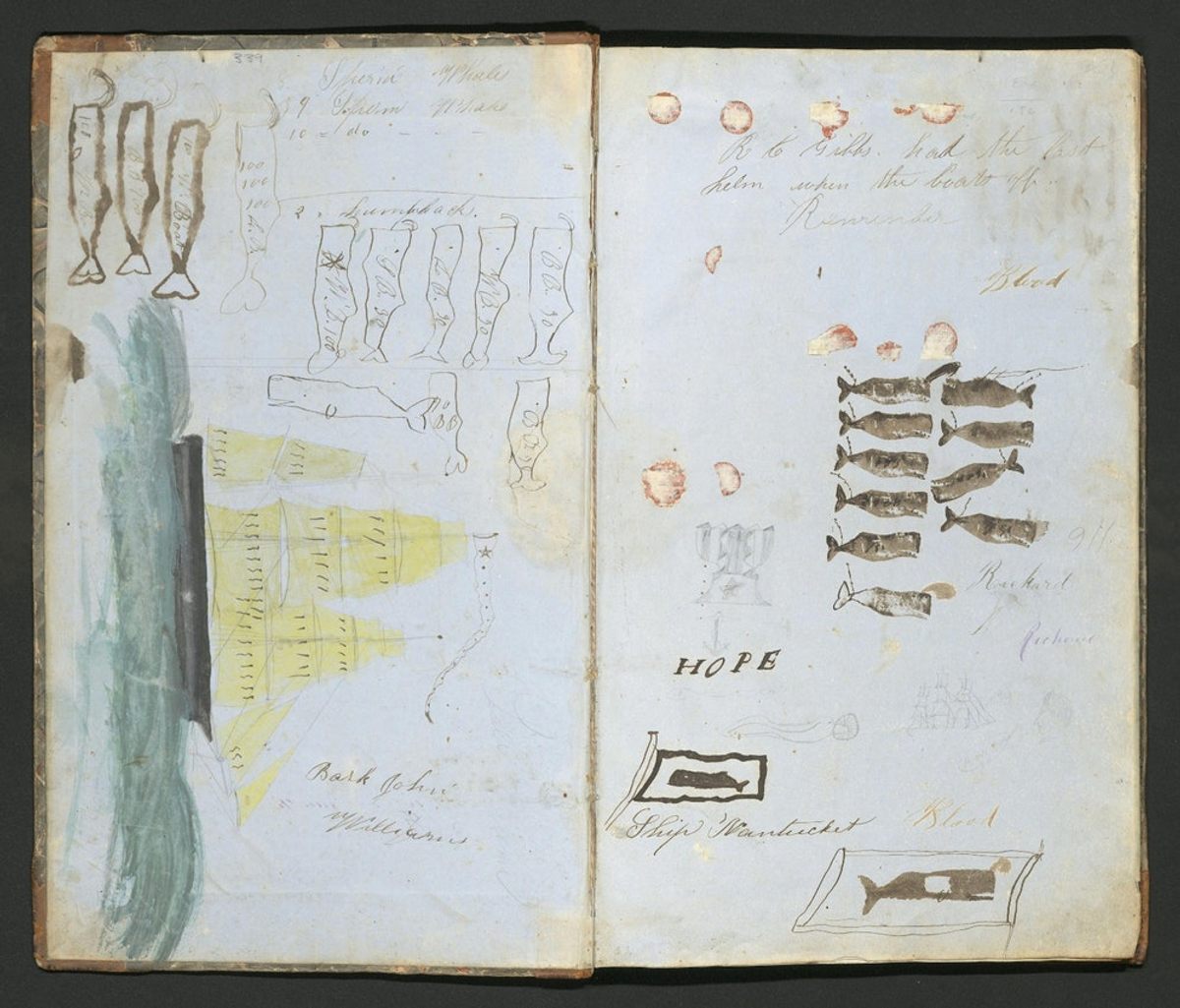
Richard complains of his and his family’s inadequacies: their failure to catch enough whales and consequent inability to make their fortunes at sea. But his condemnations of ineptitude may have been unfounded: By 1840, global whaling grounds had been sorely overfished. This fact, combined with a rising demand for petroleum and its derivative, kerosene, produced in the oilfields of Pennsylvania, undermined the North American whaling market. By the 1870s, a series of events including the Great Fire of 1846 and the American Civil War, had brought Nantucket to its knees. No local industry could succeed or replace the whale fishery—and so between 1840 and 1870, its population plummeted from almost 10,000 to little more than 4,000. Nantucket’s heyday was over.
And so the island’s grizzly whaling trade proved fallible, but not forgettable: It remains vividly in the journals and logs of its practitioners. The illustrations of these accounts constitute a form of folk art which affords remarkable insight into the extraordinary lives and creativity of the Nantucketers, in the era before their “greasy luck” ran out.




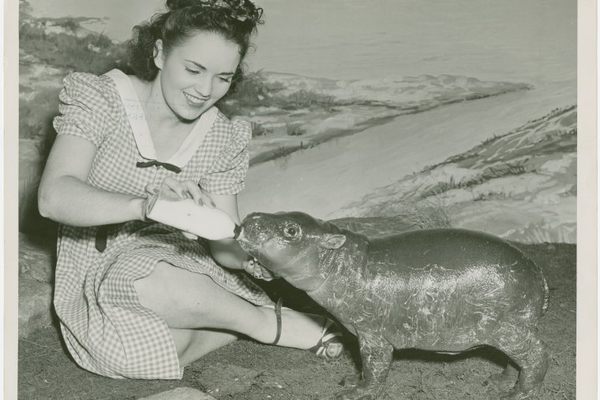




















Follow us on Twitter to get the latest on the world's hidden wonders.
Like us on Facebook to get the latest on the world's hidden wonders.
Follow us on Twitter Like us on Facebook